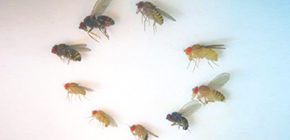
Principle of size evolution: Close relationship between sexual maturation and body size
A group of researchers from RIKEN and Osaka University clarified that attaining critical size is an important factor to determine the final size of individual insect species, which induces their sexual maturation or metamorphosis.
Many animals do not grow indeterminately even with sufficient food, and stop growing when they reach a certain body size, a “developmental threshold” or “critical size.” Growth cessation often accompanies a life history transition, such as sexual maturation or metamorphosis, which is mediated by the action of hormones such as ecdysteroid, a molting hormone in insects.
The final size of animals is determined by only three determinants: critical size, terminal growth period (TGP), and growth rate during the TGP. It is thought these three determinants are behind body size evolution (even evolution leading to species differentiation); however, how much these determinants contribute to individual body size evolution was not well-known.
This joint research group found that in 9 Drosophila species final larval size (weight) was proportional to critical size (weight), which triggered metamorphosis during the larval stage. Because the observed variation in critical size quantitatively agrees with the interspecific scaling relationship predicted by the life history model for holometabolous insects, it is thought that attaining critical size mediates an energy allocation switch between juvenile and adult tissues.
The group also found that the proportional relationship between critical size and final body size (the mechanism underlying critical size scaling) could be explained by the inversely proportional relationship between the TGP and growth rate and that interspecific differences during the TGP could be traced back to the temporal scaling of ecdysteroid hormone dynamics. In addition, there was clear interspecific variation in the rate of increase of ecdysteroid titer, that is, the species with a shorter TGP had faster rates of ecdysteroid increase.
Insulin growth factor signaling and/or TOR signaling that control the ecdysteroid synthesis rate is also related to growth control in animal species, including insects. Because IIS and/or TOR signaling simultaneously regulate both growth rate and TGP, these may serve as an underlying mechanism for scaling critical size during evolution.
These findings suggest an evolutionary principle for size determination based on an interspecific scaling relationship between critical size and final larval size. They concluded that critical size adaptively optimizes energy allocation and had a central role in organism size determination.
Their research results will help solve the relationship between the developmental process (from the larval stage to the TGP with sexual maturation) and body size evolution. By developing an energy allocation model that accounts for organism-specific life history, universal principles that govern the evolution of size determinants in organisms will be found.

Figure 1

Figure 2

Figure 3

Figure 4

Figure 5
The article, “Optimal scaling of critical size for metamorphosis in the genus Drosophila,” was published in iScience at DOI: https://doi.org/10.1016/j.isci.2019.09.033 .
Related links
- Fujimoto Laboratory, Graduate School of Science, Osaka University (link in Japanese)
